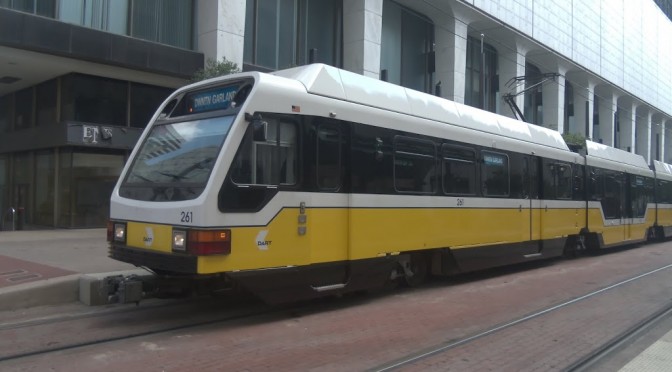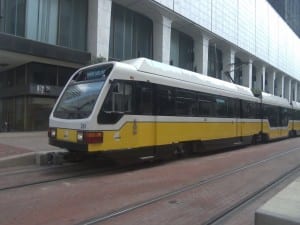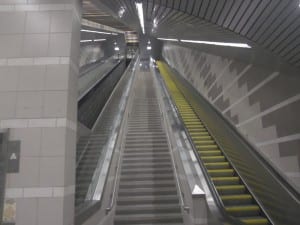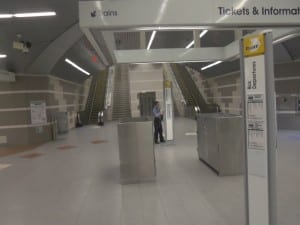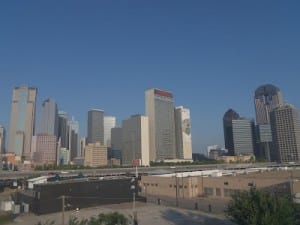Over the weekend, I took a trip to investigate Dallas’ DART rail system, spending two days in the city without a car. I didn’t even drive up there. Thanks to the new Megabus service (and $60 cab fare to and from Grand Prairie), I was able to make the nearly 500-mile trip through mass-transit services.
I know what you’re thinking… two days in a strange city with Texas triple-digit heat while my car and it’s life-saving A/C sit idle in Houston? Insane, right?? It actually turned out to be quite the educational experience, and was a great examination of DART and how it’s important service impacts the North Texas region. Here’s what I learned…
At 72 miles and counting, the DART Rail system is the longest light-rail system in the United States. To be clear, by “light rail”, it is mainly referring to the type of vehicles used, as they are not capable of operating at faster speeds than heavy rail modes (such as the NYC subway). But DART is something of a hybrid system. Most of the rail miles are either at-grade (street level) or elevated, but one station is actually a subway which we’ll get to in just a bit. The primary function is as commuter rail between the city and it’s vast suburbs. The system is also expanding rapidly, with a connection to Irving opening this month, an extension into the suburb of Rowlett this December, and a full connection planned to D/FW Airport set for 2014. Either way, for an American city, 72 miles of rail transit is quite the accomplishment.
The light rail is definitely expansive, but still manages to be quite disconnected from some parts of the city. While it does connect downtown to key suburbs of Plano, Garland and Carrollton, the line misses many of the city’s major employment centers. For the ones that are served by the rail line, the stations are often planned in an inconvenient pattern. A good example of this is on the new Green Line. The Inwood station also services Dallas/ Love Field airport, but rather than build a direct terminal connection, DART rail had to settle for an approximate location and run a shuttle between the rail stop and the airport. However, one stop that works extremely well on the Red Line is the Downtown Plano station. It’s built right into the fabric of the city’s historic downtown, and puts you right in the middle of lively shops and scenery. The living area, employment center, and transit connection all converge in harmony at this stop. In other suburbs like Garland and Carrollton, the potential is definitely there for a similar situation. But these areas are mainly connecting a small group of people where they live. Connecting major employment centers would serve a larger number of the D/FW population.
Ah, Cityplace station. The only operating subway station between St. Louis and the West Coast. It is quite a feat of ingenuity and sheer determination on behalf of the people of Dallas, and something they “should” be proud of. As an avid transit enthusiast, It’s really a spectacular thing to behold.
The only problem?? Cityplace, 12 years after its opening, sits virtually empty. The handful of passengers I saw at the station barely justify a project worth hundreds of millions in taxpayer money. It is hurt greatly by the fact that there is very little encouragement to be used as a transit hub except for the bus stops and historic streetcar. But it’s just “far enough away” that it discourages Uptown residents from use, and only serves as a midway between more popular points on the Red and Blue lines, such as Mockingbird Staion or Downtown. The sad truth is, Dallas spent lots of time building a random Subway station, when those millions of hub investment should have been poured into downtown. Yet the downtown stations are at street-level, but easily have 3 times the number of people as Cityplace staion at any point of the day. Given the wary economic climate, it will definitely be an uphill battle if Dallas, and anywhere else in Texas, ever wants to have subway in the future. That fate rested on the rousing success of Cityplace and sadly it has not delivered.
Cityplace Station (friday evening)
Cityplace Station (Saturday)
Another serious issue with DART rail? Fare collection. Yet again another light rail that works on the “honor system” assuming that people will pay their fare to ride. This is true for most people, but a VERY significant number of citizens are riding the rail for free. Even when fare inspectors were present on the train, I didn’t see them write a single citation to fare dodgers. That sends a terrible message to observers by encouraging others to follow suit.
Why is fare collection so important? Because in states like Texas, where any notion public transit is an uphill battle, we need to know the truth about our ridership numbers so that people will understand that these systems are needed and utilized. Of course the obvious? DART is losing money! In my brief trip, I observed at least 40 dodgers in my section of the rail car. Those were just on the select trips that I took. On a daily basis, a conservative estimate on all lines would easily reach the hundreds. So a couple hundred people not paying fares every day?? You do the math.
Though DART Rail is far from perfect, it has given the citizens of D/FW one very important and special gift… true mobility. This is much farther than in the sense of just transit. Because the system covers such a wide area, many citizens who may not have a car are able to travel to places they may not have thought to by bus. Take all of those quaint shops in Downtown Plano for example. Unlike your high-skill employment sectors, jobs in the suburbs may be more easily adaptable to workers that don’t have specialty training. The Red Line and other DART Rail lines make it possible for someone who can’t afford a vehicle to have a safe and reliable way to work, even if they find a job that isn’t so close to their home. By connecting these key suburbs to the city population, Dallas also connects its citizens to more job opportunities. So in the truest sense of the word, DART is able to achieve mobility both from the transit perspective, but also improve quality of life for citizens of all economic classes.
So there’s still some definite work to be done with DART, but I applaud the efforts of the people of D/FW for working hard on transit. They are building the path to a better Dallas, and a better Texas for all.
